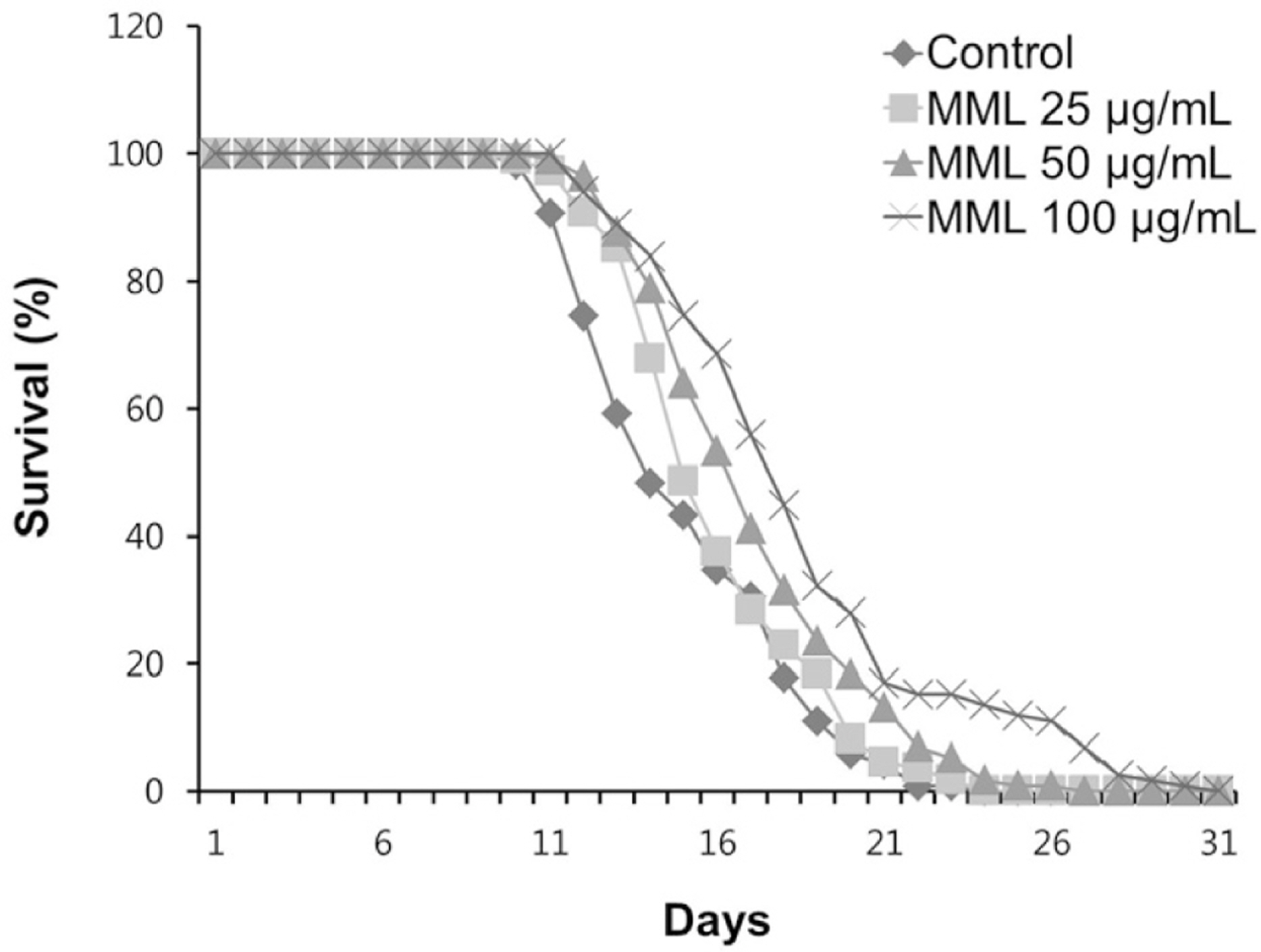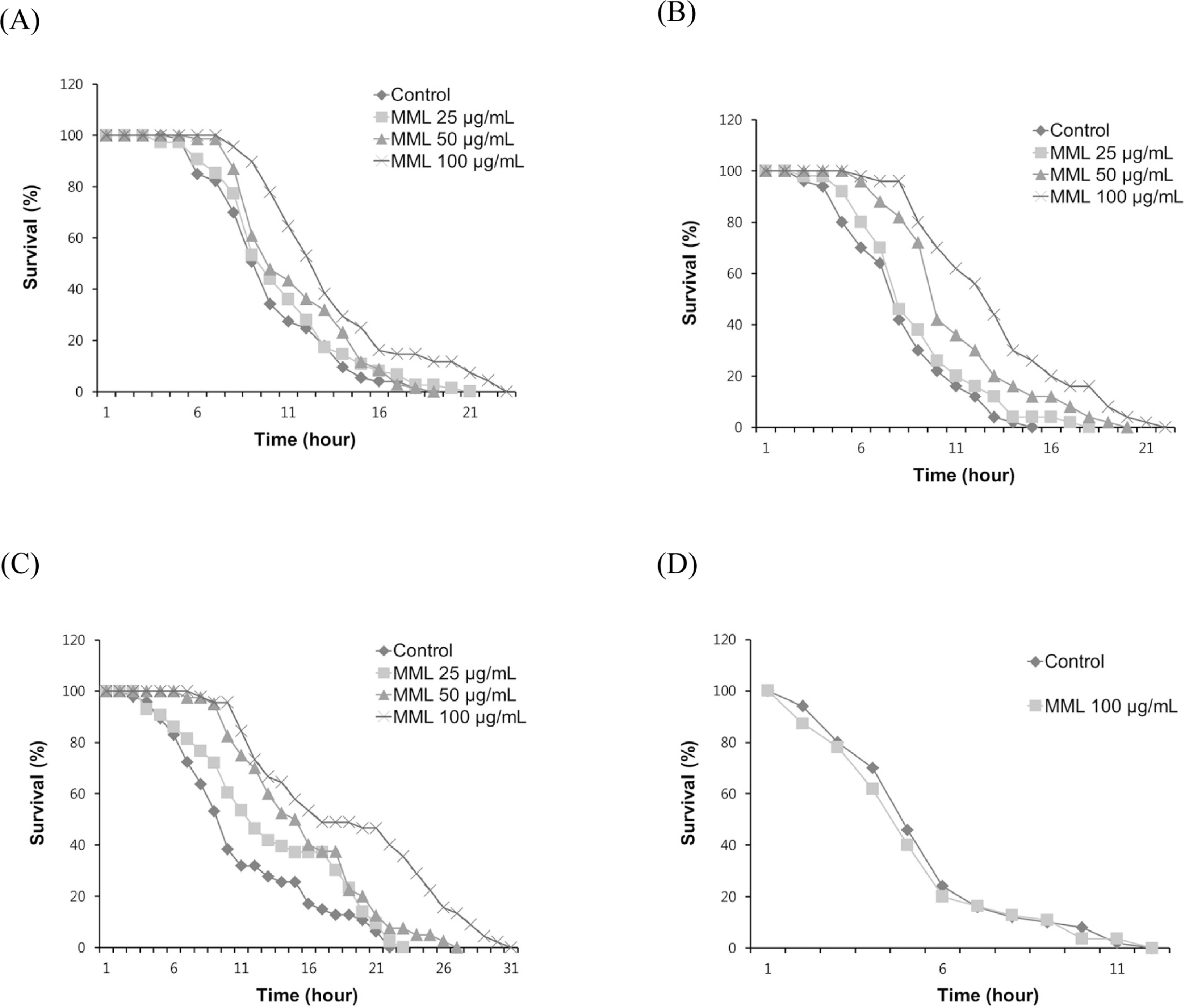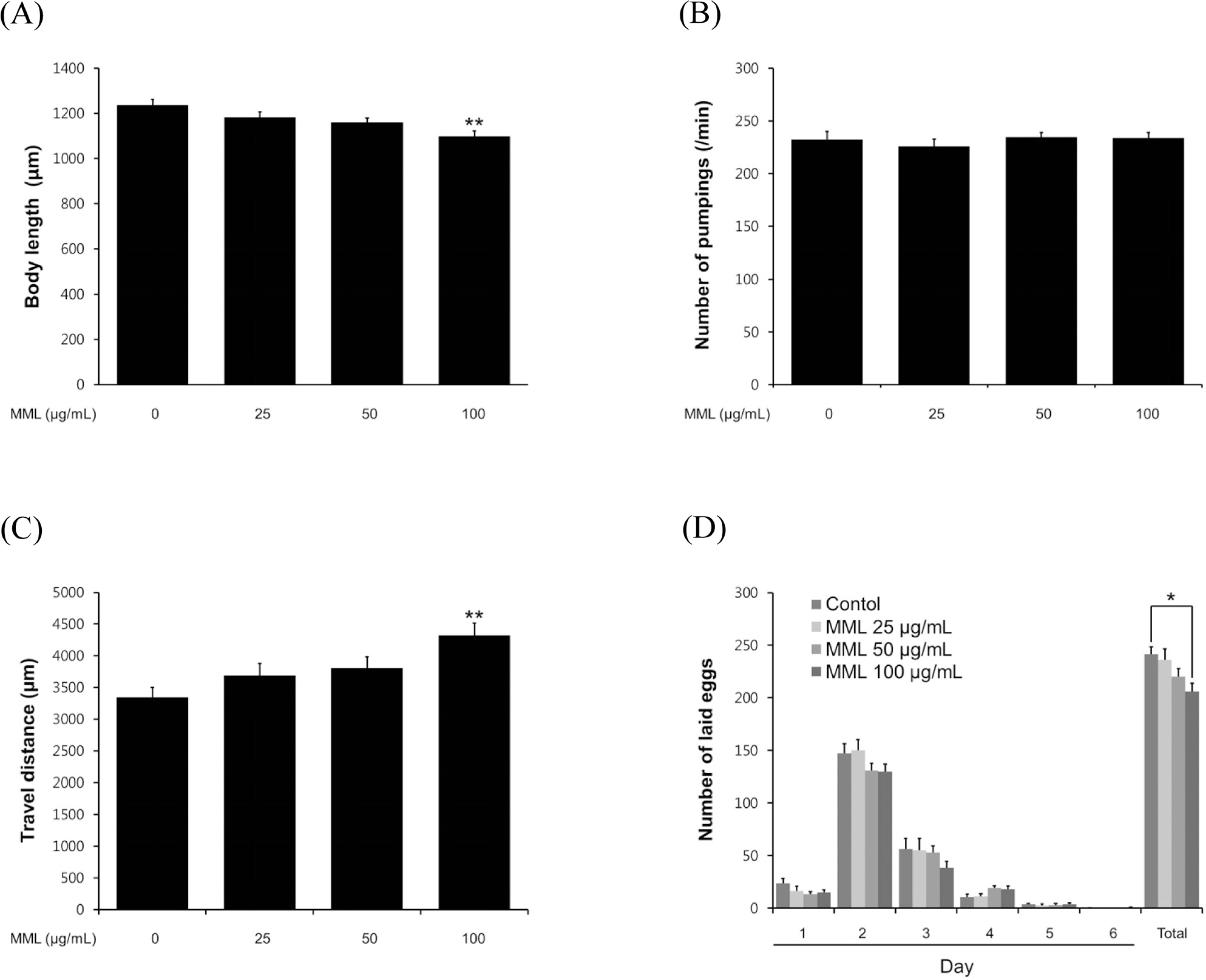Nat Prod Sci.
2016 Sep;22(3):201-208. 10.20307/nps.2016.22.3.201.
Moringa oleifera Prolongs Lifespan via DAF-16/FOXO Transcriptional Factor in Caenorhabditis elegans
- Affiliations
-
- 1College of Pharmacy, Woosuk University, Jeonbuk 55338, Korea. jeonh@woosuk.ac.kr
- KMID: 2355146
- DOI: http://doi.org/10.20307/nps.2016.22.3.201
Abstract
- Here in this study, we investigated the lifespan-extending effect and underlying mechanism of methanolic extract of Moringa olelifa leaves (MML) using Caenorhabditis elegans (C. elegans) model system. To define the longevity properties of MML we conducted lifespan assay and MML showed significant increase in lifespan under normal culture condition. In addition, MML elevated stress tolerance of C. elegans to endure against thermal, oxidative and osmotic stress conditions. Our data also revealed that increased activities of antioxidant enzymes and expressions of stress resistance proteins were attributed to MML-mediated enhanced stress resistance. We further investigated the involvement of MML on the aging-related factors such as growth, food intake, fertility, and motility. Interestingly, MML significantly reduced growth and egg-laying, suggesting these factors were closely linked with MML-mediated longevity. We also observed the movement of aged worms to estimate the effects of MML on the health span. Herein, MML efficiently elevated motility of aged worms, indicating MML may affect health span as well as lifespan. Our genetic analysis using knockout mutants showed that lifespan-extension activity of MML was interconnected with several genes such as skn-1, sir-2.1, daf-2, age-1 and daf-16. Based on these results, we could conclude that MML prolongs the lifespan of worms via activation of SKN-1 and SIR-2.1 and inhibition of insulin/IGF pathway, followed by DAF-16 activation.
MeSH Terms
Figure
Reference
-
(1). Castillo-Quan J. I., Kinghorn K. J., Bjedov I.Adv. Genet. 2015; 90:1–101.(2). Stohs S. J., Hartman M. J.Phytother. Res. 2015; 29:796–804.(3). Anwar F., Latif S., Ashraf M., Gilani A. H.Phytother. Res. 2007; 21:17–25.(4). Kumar Gupta S., Kumar B., Srinivasan B. P., Nag T. C., Srivastava S., Saxena R., Aggarwal A. J.Ocul. Pharmacol. Ther. 2013; 29:419–426.(5). Ndhlala A. R., Mulaudzi R., Ncube B., Abdelgadir H. A., du Plooy C. P., Van Staden J.Molecules. 2014; 19:10480–10494.(6). Waterman C., Cheng D. M., Rojas-Silva P., Poulev A., Dreifus J., Lila M. A., Raskin I.Phytochemistry. 2014; 103:114–122.(7). Sashidhara K. V., Rosaiah J. N., Tyagi E., Shukla R., Raghubir R., Rajendran S. M.Eur. J. Med. Chem. 2009; 44:432–436.(8). Bass T. M., Weinkove D., Houthoofd K., Gems D., Partridge L.Mech. Ageing Dev. 2007; 128:546–552.(9). Abbas S., Wink M.Planta Med. 2009; 75:216–221.(10). Saini R. K., Shetty N. P., Prakash M., Giridhar P. J.Food Sci. Technol. 2014; 51:2176–2182.(11). Sadowska-Bartosz I., Bartosz G.Biomed Res. Int. 2014; 2014:404680.(12). Brenner S.Genetics. 1974; 77:71–94.(13). Lithgow G. J., White T. M., Melov S., Johnson T. E.Proc. Natl. Acad. Sci. U. S. A. 1995; 92:7540–7544.(14). Lee E. Y., Shim Y. H., Chitwood D. J., Hwang S. B., Lee J., Paik Y. K.Biochem. Biophys. Res. Commun. 2005; 328:929–936.(15). Mekheimer R. A., Sayed A. A., Ahmed E. A. J.Med. Chem. 2012; 55:4169–4177.(16). Horikawa M., Sakamoto K.Biochem. Biophys. Res. Commun. 2009; 390:1402–1407.(17). Aebi H.Methods Enzymol. 1984; 105:121–126.(18). Kenyon C. J.Nature. 2010; 464:504–512.(19). Krishnamurthy P. T., Vardarajalu A., Wadhwani A., Patel V.Indian J. Exp. Biol. 2015; 53:98–103.(20). Swindell W. R.Aging (Albany NY). 2009; 1:573–577.(21). Solomon A., Bandhakavi S., Jabbar S., Shah R., Beitel G. J., Morimoto R. I.Genetics. 2004; 167:161–170.(22). Liu J., Zhang B., Lei H., Feng Z., Liu J., Hsu A. L., Xu X. Z.Cell Metab. 2013; 18:392–402.(23). Partridge L., Gems D., Withers D. J.Cell. 2005; 120:461–472. 2005.(24). Bordone L., Guarente L.Nat. Rev. Mol. Cell Biol. 2005; 6:298–305.(25). Mörck C., Pilon M.BMC Dev. Biol. 2006; 6:39.
Article(26). Bokov A., Chaudhuri A., Richardson A.Mech. Ageing Dev. 2004; 125:811–826.(27). Murphy C. T., McCarroll S. A., Bargmann C. I., Fraser A., Kamath R. S., Ahringer J., Li H., Kenyon C.Nature. 2003; 424:277–283.(28). Schaffitzel E., Hertweck M.Exp. Gerontol. 2006; 41:557–563.(29). Tissenbaum H. A., Guarente L.Nature. 2001; 410:227–230.(30). Berdichevsky A., Viswanathan M., Horvitz H. R., Guarente L.Cell. 2006; 125:1165–1177.(31). Mouchiroud L., Houtkooper R. H., Moullan N., Katsyuba E., Ryu D., Cantó C., Mottis A., Jo Y. S., Viswanathan M., Schoonjans K., Guarente L., Auwerx J.Cell. 2013; 154:430–441.(32). Adachi H., Ishii N. J.Gerontol. A Biol. Sci. Med. Sci. 2000; 55:B280–B285.(33). Oh S. W., Mukhopadhyay A., Svrzikapa N., Jiang F., Davis R. J., Tissenbaum H. A.Proc. Natl. Acad. Sci. U. S. A. 2005; 102:4494–4499.(34). Antebi A.Nature. 2007; 447:536–537.(35). Park S. K., Tedesco P. M., Johnson T. E.Aging Cell. 2009; 8:258–269.
Article
- Full Text Links
- Actions
-
Cited
- CITED
-
- Close
- Share
- Similar articles
-
- Acute Pancreatitis Induced by Moringa Oleifera in a 48 years Old Korean Women: A Case Report
- Induction of Apoptosis with Moringa oleifera Fruits in HCT116 Human Colon Cancer Cells Via Intrinsic Pathway
- High glucose diets shorten lifespan of Caenorhabditis elegans via ectopic apoptosis induction
- Mechanisms of aging-related proteinopathies in Caenorhabditis elegans
- Comparative study of oxidative stress caused by anthracene and alkyl-anthracenes in Caenorhabditis elegans






